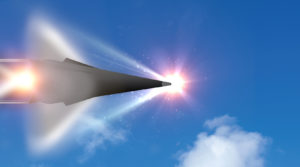The Army awarded Lockheed Martin [LMT] and Dynetics two Other Transaction Authority (OTA) contracts worth over $300 million each for work on the long-range hypersonic weapon (LRHW).
Lockheed Martin won $347 million as part of a multi-year hypersonic weapons development contract to support the LRHW long-range precision strike missile. The company will help develop and integrate a land-based hypersonic strike prototype on a truck with the Army Hypersonic Project Office, within the Army Rapid Capabilities and Critical Technologies Office.

The industry team also includes Dynetics Technical Solutions (DTS), Integrated Innovation Inc. (i3), Verity Integrated Systems, Martinez & Turek, and Penta Research.
As a subcontractor, DTS will develop launchers with hydraulics, outriggers, and power generation and distribution for the LRHW ground platform. It will also provide flight test and training support.
The LRHW program work will occur at Lockheed Martin’s facilities in Alabama, Colorado, California, and Texas.
The Army also awarded DTS a $352 million contract as leader of a team building the first commercially manufactured set of Common-Hypersonic Glide Body (C-HGB) systems. The C-HGB will be made available to all the military services.
Under this contract, DTS will produce 20 glide body assemblies with an option for additional units. The company noted it will “collaborate with Sandia National Laboratories for development and production of the glide body.”
The C-HGB team also includes Raytheon [RTN], General Atomics Electromagnetic Systems, and Lockheed Martin, which will together complete the assembly, integration, and test at the companies’ North Alabama locations.
Raytheon is the principal subcontractor and will build and deliver control, actuation and power-conditioning subassemblies that control flight of the new common hypersonic glide body. It will also help assemble and test the new glide body.
General Atomics will provide cable, electrical and mechanical manufacturing. It will cover engineering, program management, and production support from its San Diego; Huntsville, Ala.; and Tupelo, Miss., locations.
Lockheed Martin, in turn, will support manufacturing, assembly, integration, test, systems engineering and analysis from its Alabama, Colorado, and California facilities.
“Dynetics has been developing enabling technologies for many years. The common hypersonic glide body is a vital component in the National Defense Strategy that includes weapons with increased power. Our team is pleased the Army saw that our highly-skilled engineers and technicians can bring this technology rapidly and affordably to the warfighter,” DTS President Steve Cook said in a statement.
The Army plans for the LRHW prototype to use the C-HGB “and introduce a new class of ultrafast and maneuverable long-range missiles with the ability to launch from ground mobile platforms,” Lockheed Martin said in a statement.
These OTA awards include the design, integration, and production work that will lead to a set of flight tests starting in 2021. That, in turn, is expected to lead to the Army fielding a prototype LRHW battery, made of four trucks, launchers, and missile rounds along with a command and control system.
These contracts will have Lockheed Martin integrate a launcher that can work with the DTS-developed C-HGB on an existing refurbished trailer and truck. The LRHW system prototype is scheduled to be fielded with “residual combat capability” by fiscal year 2023.
Eric Scherff, vice president for Hypersonic Strike Programs for Lockheed Martin Space, underscored the company is proud to work on the hypersonic systems.
“There are natural synergies with our industry teammates. We believe our relationships offer the Army unmatched expertise and puts us in the best position to deliver this critical capability to the nation. Lockheed Martin is proud to partner with the Army in integrating the common hypersonic glide body and the land-based hypersonic strike weapon system prototype. We are committed to combining the best of what our companies have to offer to deliver on this national priority program,” Scherff said in a statement.
“The Common-Hypersonic Glide Body and Long-Range Hypersonic Weapon programs will modernize our national capabilities and will counter the threat from our foreign adversaries. We are looking forward to the progress our teams will make as we deliver this combat capability to the warfighter,” DTS’ Cook added.